Wellerman

The Sea Shanty craze may have died down a bit. But that provides an excuse for a site like ours, focused on music history, to take up the topic. Of course, sea shanty history didn’t begin with Nathan Evans’ TikTok recording, but he did set off the recent craze. He has now quit his day job and signed a recording contract. Good for him.
I think the craze had much to do with the lockdown and the fact that TikTok allowed users to sing along with the original and post the “duet.” It was a way of connecting. People could rip off their masks and act like rugged individualists. Mass participation in online renditions of Wellerman naturally followed.
Appropriately so. Sea shanties were meant to be sung by a group. They are one manifestation of work songs that have the practical purpose of keeping workers in sync. Hard physical labor requiring a group effort needs coordination whether it’s hammering spikes on the railroad or heaving on ropes.
Shanties have been around for a long time. There are societies for singing shanties and regular workshops and festivals. Whether shanties retain their current wide audience or not, they will continue to have a core, devoted following.
In comments for a news article, ethnomusiciologist Gibb Schreffler pointed out another important factor: Sea shanties give people permission to sing. Now there’s a topic dear to Professor Carol’s heart! She regularly laments that America is not a singing culture.
Schreffler says people feel freer to sing when it’s clearly just all in good fun—not to be taken seriously. Exactly, and good fun has always been a major reason why people sing.



